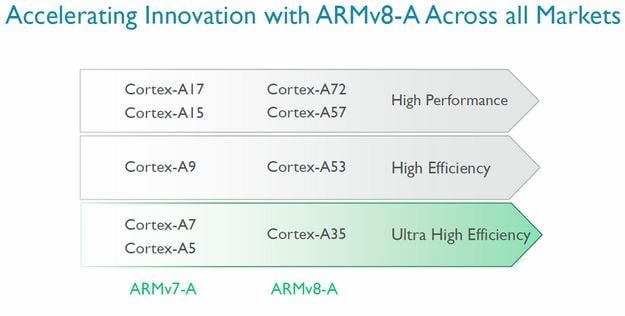ARM Launches Low Power 64-bit Cortex-A35 For 'The Next Billion Smartphone Users'
If you purchased a higher-end smartphone in the past two years, chances are good that it has an SoC under its hood that packs ARM's ARMv8 architecture. It's what made 64-bit mobile processors possible, and with that comes increased performance as well as the ability to utilize lots of memory, among other processing efficiencies.
Today, it's not hard to find ARMv8 in even modest smartphones, some of which could cost under $100. But in emerging markets, the architecture has been nonexistent. This is a problem ARM is planning to solve. It plans to do that with its brand new Cortex-A35, a microarchitecture that aims for ultra high efficiency and will target the "next billion smartphone users and beyond."

Once available, the Cortex-A35 will replace both the Cortex-A7 and Cortex-A5. As expected, efficiency all-around is vastly improved over those earlier models. In Geekbench, up to a 40% gain in performance can be seen, while in an overall integer test, a 6% boost can be expected. There are no jaw-dropping gains here, but they are appreciable gains nonetheless. It's notable that with this performance boost comes a 10% reduction in overall power - another perk that many in these growth markets will appreciate.
The 1GHz Cortex-A35 is built on a 28nm process, and consumes less than 90mW per core at load. While this chip will bring with it the obvious benefit of 64-bit application support, ARM notes that it can also boost the performance of 32-bit applications up to 20%. All of this leads the company to dub the A35 the "performance-per-milliwatt leader".


Compared to the previously released Cortex-A53, the Cortex-A35 enjoys cores that are 25% smaller, use 32% less power, and are 25% more efficient. Similar to the A53, the A35 utilizes an 8-stage pipeline.


ARM's Cortex-A35 looks to be a great follow-up to the previous ultra high efficiency generation, but it will unfortunately not be available right away. ARM's prediction is that the chips will begin to roll out in late 2016 but again will likely be employed in lower cost, mainstream devices that address emerging market requirements.

